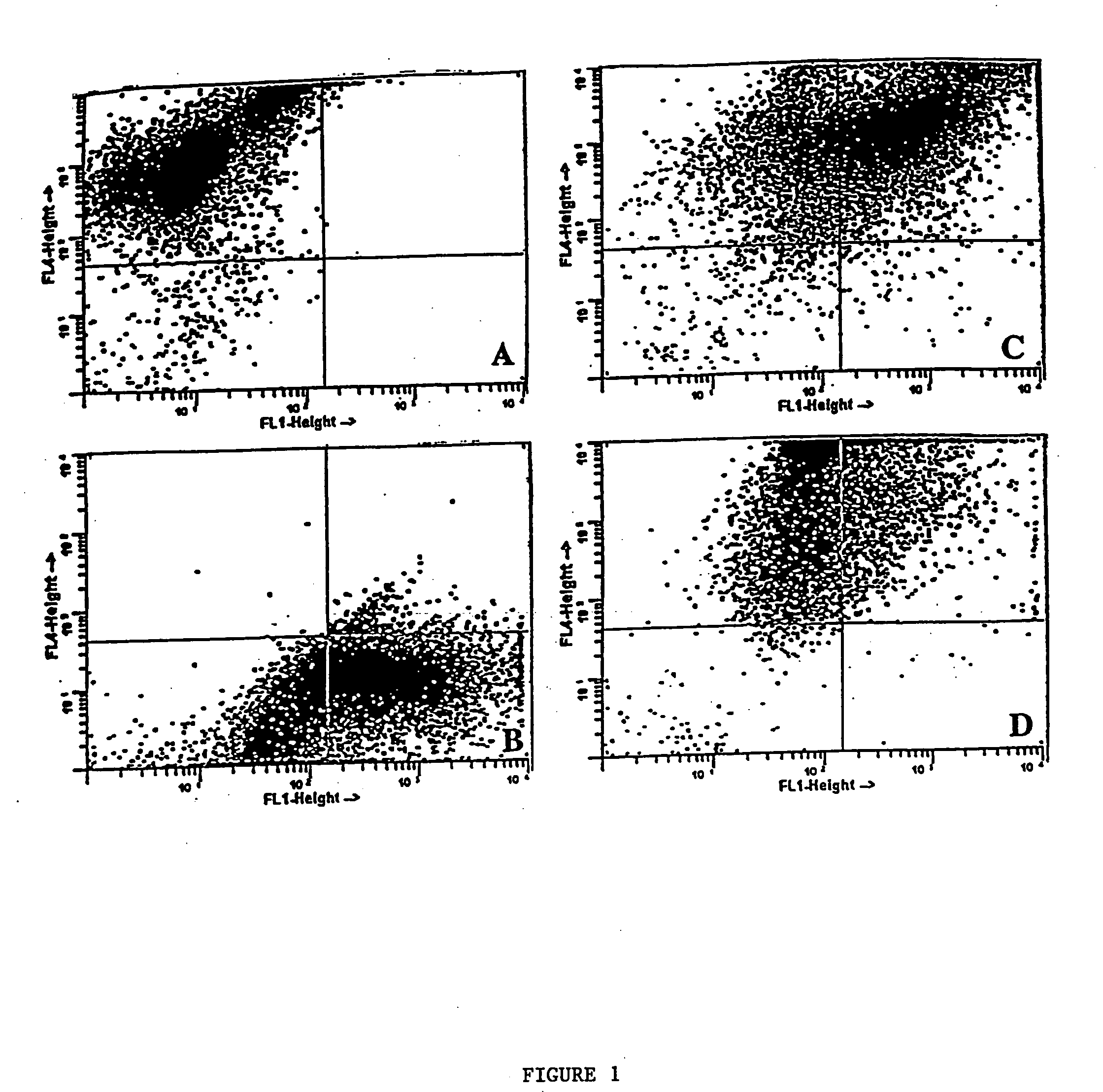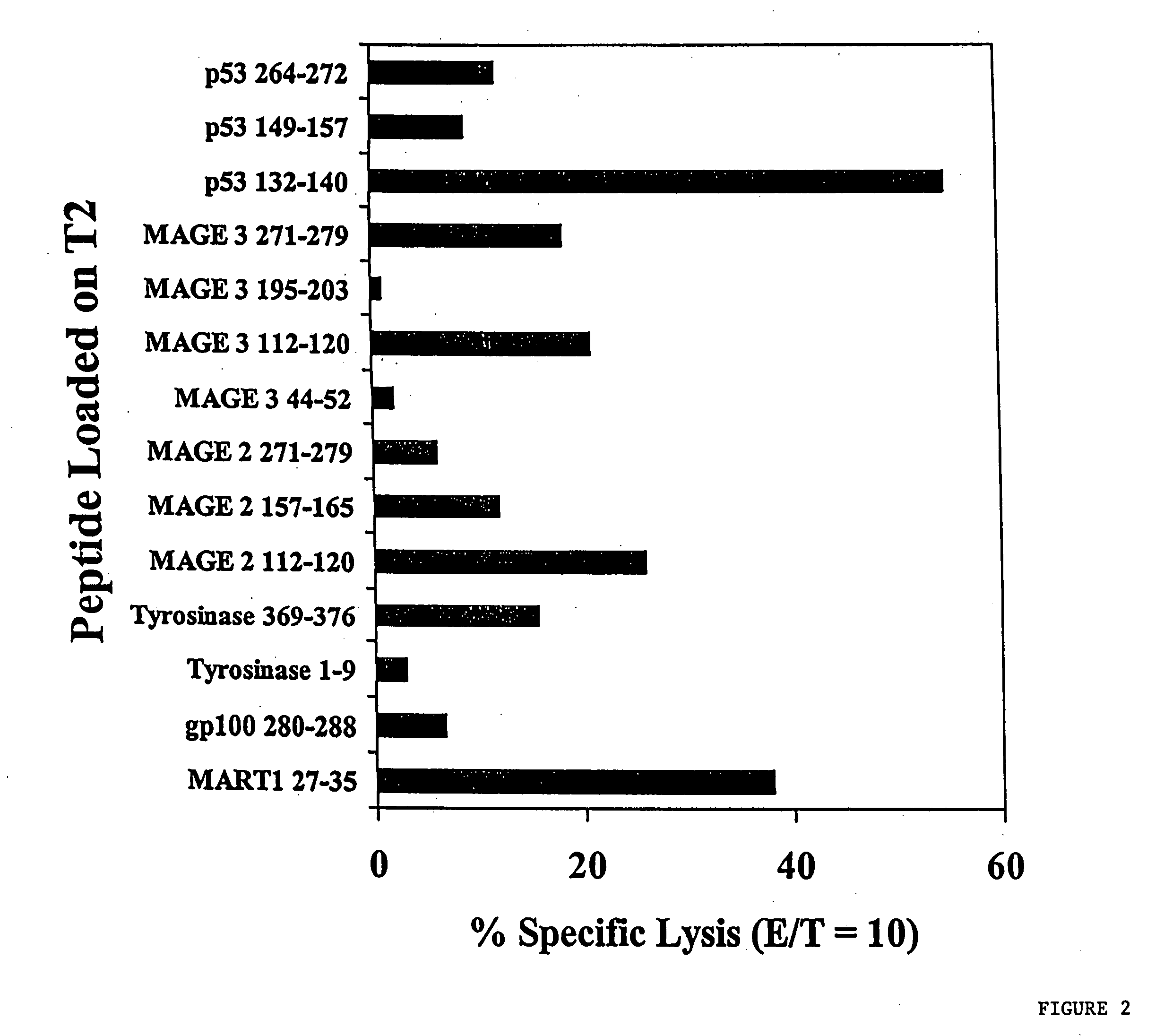In vitro induction of antigen-specific T-cells using dendritic cell-tumor cell or dendritic cell-viral cell derived immunogens
- Summary
- Abstract
- Description
- Claims
- Application Information
AI Technical Summary
Benefits of technology
Problems solved by technology
Method used
Image
Examples
example 1
Fusion of DCs and Tumor Cells
[0052] Dendritic cells were prepared from bone marrow as generally described in Celluzzi et al., J. Exp. Med. 183: 283-287 (1996) using GM-CSF as described in the reference. Briefly, bone marrow cells were depleted of lymphocytes and cultured at 5×105 cells / ml in 10% FCS-containing RPMI 1640, obtained from Irvine Scientific, Santa Ana, Calif., with granulocyte macrophage-colony stimulating factor (GM-CSF), in a concentration of 103 U / ml, obtained from Sigma Chemical Company, St. Louis, Mo. Loosely adherent cells were collected on day 6 for fusion. Between about 50 and 75% of the DCs expressed CD86 (B7.2) and Class II MHC (I-A+) antigens, as determined by flow cytometry.
[0053] Day 6 DCs were fused with either B16 or 3LL cells at a ratio of 6:1, DC to tumor cells, using polyethylene glycol at 37° C. After washing by centrifugation, fused cells were cultured overnight at 37° C. in RPMI 1640 (10% FCS).
example 2
Preparation of Dendritic Cell and Tumor Cell Co-cultures
[0054] Dendritic cells were prepared according to the methods of Example 1. Day 6 dendritic cells were then used to form a co-culture with either B16 cells or 3LL cells. Each DC / tumor cell co-culture was prepared by placing DCs into test tubes with the respective tumor cells. A pellet of cells was formed by centrifugation. The pellet was then diluted with RPMI (10% FCS) and incubated overnight at about 37° C. in a 5% CO2 incubator. The ratio of DCs:tumor cells was about 6:1. The products of the co-culture were prepared to further evaluate whether tumor antigens were present in close association with DCs and to evaluate if soluble factors released from the tumors were present on the DCs.
example 3
Efficiency of Fusion and Co-Culture
[0055] To determine the efficiency of fusion and co-culture, each of the cell types—DCs, B16 and 3LL—was stained with a different lipophilic fluorochrome before fusion and analyzed using flow cytometry. The tumor cells were stained with DiO while the DCs were stained with Dil, both of which were obtained from Molecular Probes, Inc., Eugene, Oreg. After extensive washing, cells were fused or co-cultured and allowed to incubate overnight at 37° C. Harvested cells were then fixed in 2% paraformaldehyde and the forward and side scatter patterns measured on a Becton Dickinson Facstar Plus with Argon / HeNe duel laser, available from Becton Dickinson Immunocytometry Systems, San Jose, Calif.
[0056] The scatter pattern of each cell type is depicted in FIG. 1. Individual cell staining shows two distinct patterns of DCs (DiI) which shift up (upper left quadrant of FIG. 1A) or B16 tumor cells (DiO) which shift right (lower right quadrant of FIG. 1B) as compar...
PUM
| Property | Measurement | Unit |
|---|---|---|
| Time | aaaaa | aaaaa |
| Ratio | aaaaa | aaaaa |
Abstract
Description
Claims
Application Information
 Login to View More
Login to View More - R&D
- Intellectual Property
- Life Sciences
- Materials
- Tech Scout
- Unparalleled Data Quality
- Higher Quality Content
- 60% Fewer Hallucinations
Browse by: Latest US Patents, China's latest patents, Technical Efficacy Thesaurus, Application Domain, Technology Topic, Popular Technical Reports.
© 2025 PatSnap. All rights reserved.Legal|Privacy policy|Modern Slavery Act Transparency Statement|Sitemap|About US| Contact US: help@patsnap.com



